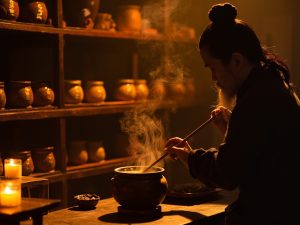Table of Contents
ToggleGui Zhi Qu Shao Yao Tang – Nan Kaiyang
Author: Nan Kaiyang Editor: Gu Yuxi Translator: Gu Yuxi
Original Text:
From Shang Han Lun (Treatise on Cold Damage), Clause 21: For Taiyang disease, after purgation, if the pulse is hasty and there is fullness in the chest, Gui Zhi Qu Shao Yao Tang is indicated.
This aligns with the principle in Clause 15: if qi rushes up to the chest after purgation, Gui Zhi Tang can be used.
Main Cause:
Upper excess and lower deficiency pattern.
Affected Population:
Individuals with a thin, white tongue coating, palpitations, shortness of breath, insufficient cardio-pulmonary function, chest tightness due to cor pulmonale, fatigue, a subjective sensation of tension in the lower abdomen; also those with pneumothorax and myocardial ischemia.
Clause Inference:
In Taiyang syndrome, where damp-water is abundant externally but purgation is mistakenly performed, it injures the Middle Qi. After purgation, there is a deficiency of fluids in the Spleen, Stomach, and small intestine, leading to a deficiency syndrome after fluid depletion (not yet reaching Yang deficiency). The external heat evil, taking advantage of the fluid deficiency after purgation, sinks into the Heart and Lungs, causing a hasty pulse at the guan position (sweating can also lead to this, as unstable cou li allows heat qi to enter Shaoyang).
The Yang Qi of the Lungs and Heart is impaired. The chest is the fu (organ) of Yang, leading to a pattern of upper excess and lower deficiency. Although purged, the exterior is not resolved, remaining on the surface. The evil qi in the chest consequently enters and forms an excess, causing the Heart and Lungs to be weak, naturally leading to obstructed breathing and a sensation of chest fullness. The excess evil tends to circulate between the chest and diaphragm. If one merely tonifies the deficiency of the Lower Jiao, residual evil will remain, exciting internal fluid retention. Therefore, it is necessary to invigorate the Yang of the Heart and Lungs and simultaneously induce sweating to resolve the exterior, thereby achieving the therapeutic goal, which is precisely the opposite of Clause 64.
Groups Prone to Chest Fullness:
1.Those with pre-existing retained fluid in the lungs or exhaustion leading to insufficient Heart function, who are unable to circulate the Qi of the Heart and Lungs. If external evil is present, they will experience fullness.
2.Those who initially had slight difficulty with urination and early water-dampness that had not yet settled between the bladder and its attachments, but were instead attacked by purging or severe purging.
Herbal Verification:
1.Shao Yao (Peony Root):
Yao Zheng Xu Bian (Continuation of Herbal Symptom Records) states that Zhongjing used Shao Yao to stop abdominal pain, and it has a strong descending nature. It would obstruct the Yang entering the Heart and chest. Furthermore, the diseased location in this clause is in the chest, not the abdomen, and it is a symptom of “fullness” not “pain.” Shao Yao’s Yin-constricting power can astringe the lungs into Yin, causing the Shaoyang layer to constrict internally and externally, which would impede the medicinal properties of Sheng Jiang and Gui Zhi, making the chest fullness and oppression even more severe.
2.Sheng Jiang (Fresh Ginger) and Gui Zhi Jian (Cinnamon Twig Tip):
Externally, they can disperse the heat qi that presses from below upwards into the lungs, releasing it through the muscles. Internally, they invigorate the fluids of the Heart and Lungs.
3.Da Zao (Jujube) and Zhi Gan Cao (Prepared Licorice):
Da Zao is used medicinally to stop spasmodic pain in the abdomen, which can be considered treating an unmanifested disease by a superior physician. It is paired with Zhi Gan Cao and Sheng Jiang to strengthen the Spleen and generate fluids, while also moderating the downward movement of fluids. When fluids are generated, dryness and heat cease. When the Spleen is strengthened, Stomach Qi is harmonized, and external evil cannot invade, thus preventing it from entering Shaoyang.
Appendix:
Other formulas for chest-located fullness: Clause 22, Clause 112, Clause 118, Clause 64. This herbal property annotation is from Lei Ju Fang (Categorized Prescriptions).
Disclaimer:
The experiences and insights shared above represent the author’s personal usage and understanding, and are provided for reference only as part of academic exchange. Please do not blindly replicate or apply them; any consequences arising from such actions are solely your responsibility. As individual constitutions vary, medication should be tailored accordingly. It is advisable to use such treatments under the guidance of a qualified physician. If you have additional experiences to share, comments and submissions are welcome.
If you appreciate my article, please give it a like.
If you are a generous and affluent individual, please consider making a donation!
Your recognition is my greatest motivation to continue writing—thank you very much!
USD Donation Button —
A RMB donation button is available below.
 微信赞赏
微信赞赏 支付宝赞赏
支付宝赞赏




